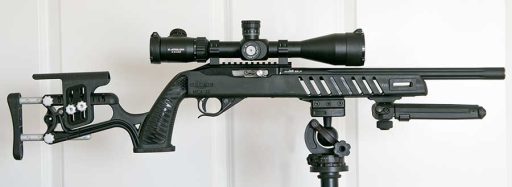While I’m at least familiar with nearly every 10/22 chassis currently available, I was pleasantly surprised by the Luth MCA-22. Most of the chassis designs I have tried are aluminum, and modular, allowing for different grips and either stocks or braces. The MCA-22 is a one piece, all-inclusive chassis. People know Luth for their highly adjustable AR-style stocks. So they have a wealth of experience with polymers, ergonomic design, and innovation. Their new MCA-22 chassis combines features from some of their best stocks, but for my favorite rimfire rifle. So I knew going in that I would like this.
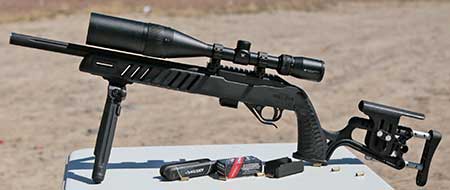
Construction and specs
Luth builds the MCA-22 chassis for the Ruger 10/22 and similar clones here in America, primarily using glass-filled nylon, with aluminum rods and knobs for adjustment, and steel bolts. That helps keep the weight down to just 2.09 pounds. Users can adjust the length of pull (LOP) from 11.25 inches to 15.75 inches in 0.75-inch increments, ensuring a good fit for a wide range of people.
Overall length within that range runs from a compact 26.5″ to a long 30.75″. At its widest point, the MCA-22 is 1.790″. The cheek riser can be adjusted from 1″ under the bore to 1″ over the bore, in 0.90″ increments. There’s also an inch of adjustment on the butt itself. Luth designed this chassis for optimal fit..
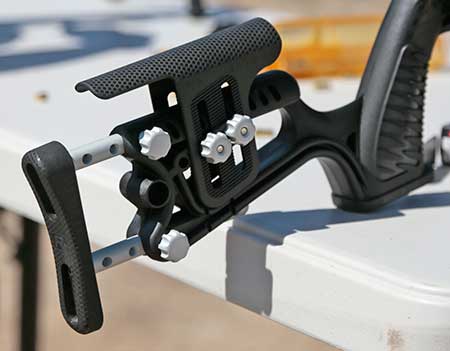
Features
Besides all that adjustment, the MCA-22 has some other nice features. Its ambidextrous gooseneck pistol grip has a nice palm swell, and aggressive texturing. On the underside of the foregrip are five M-LOK compatible slots. Plenty of room for a bipod, Arca plate, or both. The chassis includes a drilled hole for a sling stud near the front, enabling you to add a sling or mount a bipod. On either side of the foregrip are more M-LOK slots (one long one on each side).
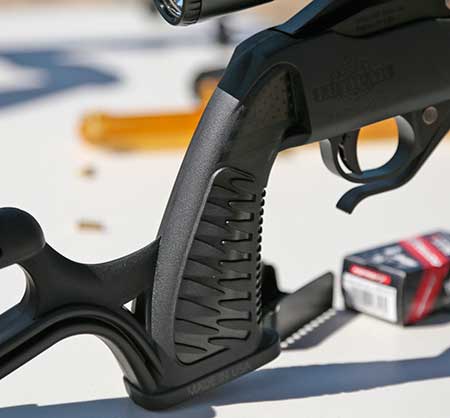
Installation
Not having a 10/22 factory tapered barrel on hand, the first thing I did was pry out the barrel insert. When using a .920″ barrel, this insert needs to be removed. Using a thin flat blade screwdriver, I popped the four little clips out while applying upward pressure on the insert. Pretty simple.
That out of the way, I tried to drop my barreled action in, and ran into a snag. My CST receiver with Timney trigger doesn’t always play well with anything other than wooden stocks. The hole for the action screw did not line up with the hole in the chassis. So I grabbed a Ruger receiver with a .920″ barrel and tried that. It fit, and snug at that. After removing it, I tried the CST/Timney combo again, and it lined up close enough that I could get the action attached. Go figure.
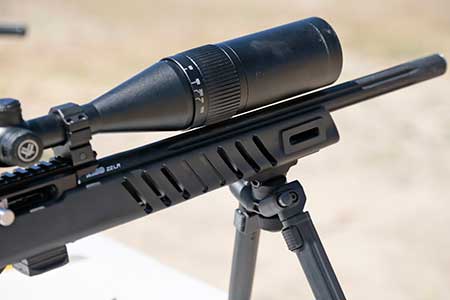
With the rifle now complete, I grabbed a Magpul bipod that I had sitting around, waiting for another project. It’s the M-LOK version, so it mounted right up to the front of the chassis. With the bipod in place, I was able to determine the correct length of pull, and then roughly set the cheekrest height. At that point, it was ready for a trip to the range.
Range time
Length of pull was just right. My concern was that the sweet spot might fall between two settings, but that was not the case. Then the cheekrest was set, and I was in business. Its gooseneck grip felt great in my large hands, with the base of my thumb falling naturally into place between it and the stock. Reach to the trigger was fine, although I suspect those with really small hands may have some issues.
When loading my bipod, the forend flexes a bit, but no matter how much I tried, I couldn’t get the barrel to contact the chassis. Thanks to the light weight, I can still shoot this rifle offhand. I threw an Arca plate adapter on the bottom, and shots from the tripod felt like cheating.
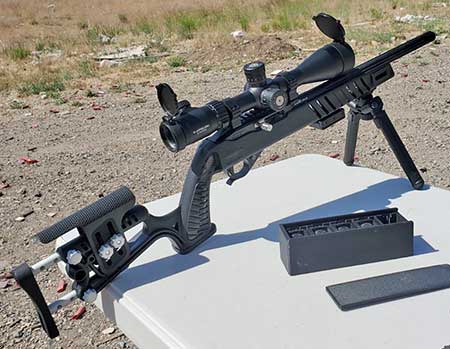
Find the Luth MCA-22 stock at Brownells
You may have noticed that this rifle has two different scopes pictured. On the first range trip, it had a Vortex Crossfire II. That scope had served me well for a while, but lacked the magnification needed to really reach out. So I swapped it out for an Athlon Argos BTR GEN2 6-24×50. This scope is a much better match for the rifle, and with the Luth MCA-22, I was able to get an even better fit. The rifle itself has always been accurate, but high winds kept me from getting the scope as dialed in as I would have liked. On the other hand, I was able to really fine tune the fit of the Luth MCA-22.
Thoughts and observations
For those accustomed to Luth stocks, it’s very “Luthy”. The feel and adjustability should be pretty familiar. When I had my .308 in a chassis, I had a Luth MBA-3 stock on it, and I really liked that stock. I also have a couple of 10/22s in a Magpul Hunter stocks, which I really like. And I realized that the MCA-22 is the perfect mix of the two, but for rimfire. It’s lighter than Magpul’s 10/22 stock, but offers actual adjustments, rather than swapping cheek risers and adding or subtracting spacers for LOP.
The rifle pictured came out of a Boyds At-One. Pretty stock, good adjustability, but man, I seem to be rough on wood stocks. So here’s a chassis that does all I could ask for, and can take a beating. My rifle seems to shoot just as well in the Luth MCA-22 as it did in the Boyds, but now it’s lighter, which isn’t a terrible thing for me.
I could see this chassis used for a field rifle with a little 2-7 scope into it. Or as something more like a Steel Challenge rifle, with a red dot and lighter barrel. If you’ve got kids, the adjustability will allow it to grow with them. And that includes not just physical size, but from plinking to competing, if that’s the path they want to take.
Conclusion
Overall, I think the Luth MCA-22 is going to be a winner. It’s not the lightest option for run and gun events, or the heaviest for benchrest. But it straddles the line between disciplines really well. Luth suggests it as an option for Steel Challenge, Practical Rimfire, or NRL22, and I think they are spot on. If you want a solid option with plenty of adjustability that can do most things really, really well, this is it. Check it out at Luth-AR.com.
As usual, I’d like to thank Luth-AR for providing their chassis for my testing and evaluation. I’ve always appreciated their innovation, and being a rimfire enthusiast, they certainly got my attention with their new chassis.
*Rifle specs
In case anyone is wondering, here’s the full spec on the rifle pictured: It’s a CST receiver with Timney trigger, JWH Custom bolt and charging handle, plus a KIDD ULW barrel. Inside is a TandemKross buffer, and their KrossPins.
